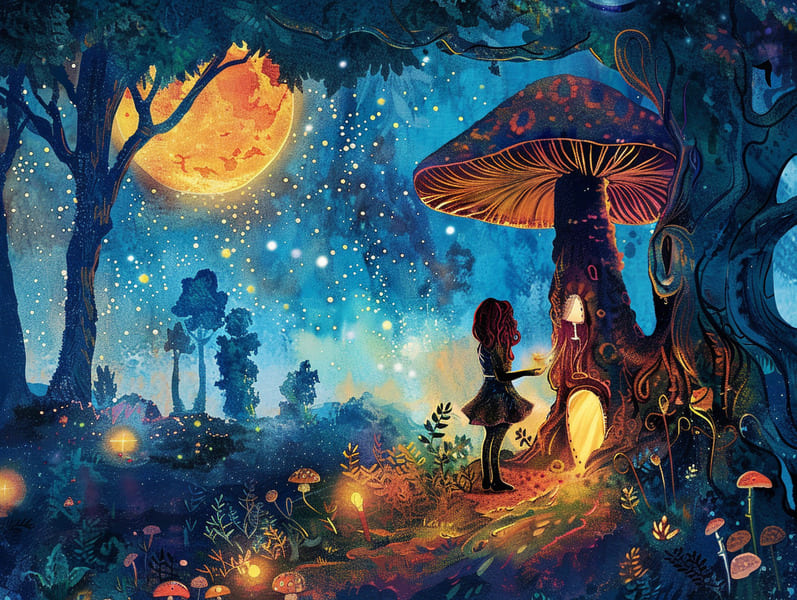The Creation of Bedtime Fairy Tales with Its Perpetual Splendor.
The Creation of Bedtime Fairy Tales with Its Perpetual Splendor.
Blog Article

Traditional fairy tales have deep roots. These stories have been shared from one generation to the next centuries before they were ever transcribed. They sprang from a variety of civilizations, including European traditions. They were initially conveyed among grown-ups, often carrying themes and messages related to the societal norms and beliefs of the time.
The Grimm brothers, Jacob and Wilhelm, were among the first to compile many of these beloved fairy tales. Their volume, "Grimm's Folk Tales," included narratives like "The Little Glass Slipper," "Little Brother and Little Sister," and "Snow White," which have since become cornerstones in the world of beloved fairy tales. Similarly, Hans Christian Andersen's whimsical stories, such as "The Sea Maid," and "The Story of the Ugly Duckling," have touched hearts worldwide, ensuring their place in the pantheon of iconic fairy tales.
Despite being ancient, these tales remain as significant as ever, especially as kids' bedtime tales. These charming stories are now available in numerous formats, including gorgeously illustrated books, charming animations, and free fairy tales online.
Their continued relevance can be connected to several fascinating points:
Important Morals: Old fairy tales often provide important moral lessons. Fairy tales like "The Boy Who Cried Wolf" teach the merit of integrity, while "The Race of the Tortoise and the Hare" underline the merits of steadfastness and humbleness. These narratives offer young ones clear distinctions between correct and incorrect, molding their moral compass in a kind yet impactful way.
Compassion and Knowledge: Traditional fairy tales frequently feature heroines facing challenges and struggles, provoking audiences to resonate with their struggles and rally behind their triumphs. For instance, "Beauty's Beast" highlights the significance of looking beyond appearances to realize the real character of a character, nurturing understanding and perception.
Cultural Comprehension: Many ancient fairy tales are saturated in the cultural contexts from which they were born. Delving into these fairy tales can provide informative snapshots into different societies, enhancing a sense of global insight and knowledge.
Creativity and Imagination: The whimsical elements in ancient fairy tales—supernatural elements—encourage children’s innovative ideas. These tales transport readers to supernatural realms, kindling fantasy ideas and a sense of delight that endures a lifetime.
Traditional fairy tales are not only captivating but also didactic. They work as alluring tools in building various cognitive and emotional skills in kids. When old fairy tales are narrated, they cultivate language proficiency by showing new lexicon and complex sentence structures. This practice also advances listening abilities and concentration, as kids focus on every detail, keen to see what happens next.
Furthermore, contemplating the themes and characters of classic fairy tales can promote cognitive skills and cognitive skills. Children are guided to detect patterns, foresee events, and grasp cause and effect. These reflections also boost children express their thoughts and feelings, adding to their emotional intelligence.
In today’s high-tech era, the prevalence of digital storybooks has made these tales more reachable than ever. Web-based platforms and programs feature huge assortments of classic fairy tales that can be seen or listened to anytime, anywhere. Fairy tales recited are particularly well-liked, supplying an engaging way for kids to relish these fascinating tales. Narrated books and spoken videos carry characters and settings to life, often paired with fantastical sound effects and soundtracks that intensify the narrative adventure.
The timeless allure of traditional fairy tales lies in their ability to adjust to changing times while preserving their fundamental ideas. Contemporary revisions of these stories often integrate more inclusive characters and modern settings, making them relevant to today’s audience. However, the basic principles of braveness, generosity, and truth remain unchanged, continuing to touch young readers of all ages.
Fairy tales also offer a sense of ease and familiarity. They grant a coherent narrative with a apparent beginning, middle, and end, often closing with the finalization of conflicts and the triumph of virtue over corruption. This assuredness can be consoling for little ones, making known a sense of awesome site reliability in an unpredictable world.
Ancient fairy tales continue to allure and train new generations, maintaining their radiance and pertinence in modern society. As children's bedtime stories, they impart upon a perfect blend of magic and knowledge, nurturing moral values, empathy, and creativity. The accessibility of online storybooks and the favor of fairy tales read out loud guarantee that these classic tales remain acquirable to new generations.
By safeguarding and narrating these fairy tales, we continue to extol the rich tapestry of mythology and cultural heritage. Whether you are delving into a vividly illustrated book, accessing a virtual library, or listening to an audiobook, the mystique of old fairy tales is always within reach. These tales show us of the ageless essence of fairy tales and its ability to link us across epochs and places.
If you are discovering a colorful picture book, perusing a virtual collection, or listening through an spoken story, the radiance of bedtime fairy tales is always within reach.
These tales convey of the continued presence of tales and its ability to bring us together across generations and cultures, forging a link that charms and informs alike.